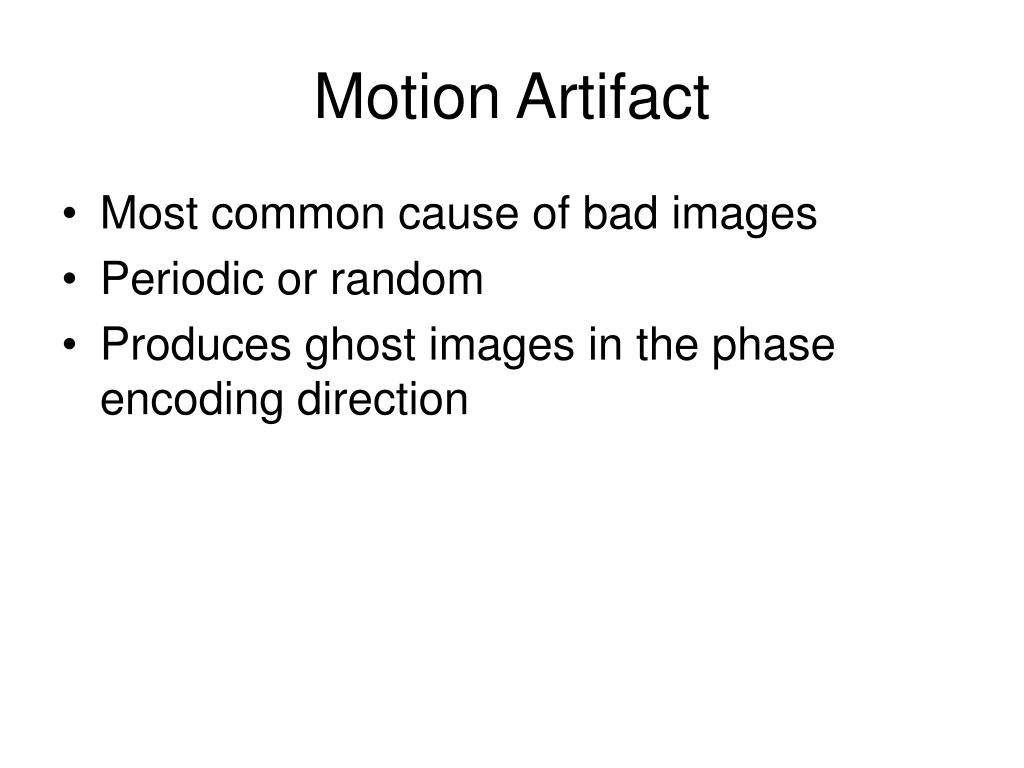

Saturday, 7 April 2018 by T2-Weighted Liver MRI Using the MultiVane Technique at 3T: Comparison with Conventional T2-Weighted MRIįriday, 16 October 2015 by Searchterm ' Motion Artifact' was also found in the following service: Thursday, 11 July 2019 by Prospective motion correction using coil-mounted cameras: Cross-calibration considerations
#Motion artifact meaning free
Wednesday, 19 February 2020 by Ĭhest MRI Using Multivane-XD, a Novel T2-Weighted Free Breathing MR Sequence KinetiCor Wins FDA 510(k) Clearance for Motion Correction System for Siemens MAGNETOM Skyra 3T Scanner View the DATABASE results for ' Motion Artifact Suppression Technique' (3).

(MAST) See Gradient Motion Rephasing and Motion Artifact.

arterial pulsation, breathing), fast imaging sequences, etc. Presaturation pulses for flow artifacts (e.g. There are different solutions for reduction of phase encoded motion artifacts.Ĭardiac and respiratory gating, breath holding, sedation of the patient, The artifact appears as bright noise, repeating densities or ghosting in the phase encoding direction. This artifact is caused by movements of the patient or organic processes taking place in the body of the patient. Phase encoded motion, motion, phase effectĬompensation techniques, more averages, anti spasmodic, presaturation

Motion-compensation of Cardiac Perfusion MRI using a Statistical Texture Ensemble (.pdf)Ĭontrolling patient's breathing makes cardiac MRI more accurateĭiffusion Weighted Imaging - Bioinformatics - MRI Accidents - General - NMR - Directories View the DATABASE results for ' Cardiac Motion Artifact' (2).Maximum reduction can be achieved by using triggering in combination with flow compensation, respiratory triggering or breath hold and regional saturation techniques. These artifacts can be reduced by using cardiac synchronization: triggering, gating or retrospective triggering. The artifacts appear in the phase encoding direction, independent of the direction of the motion. Movement of the heart causes blurring and ghosting in the images. June 2003 by Searchterm ' Motion Artifact' was also found in the following service: Tuesday, 5 January 2016 by Motion-compensation of Cardiac Perfusion MRI using a Statistical Texture Ensemble (.pdf) Patient movement during MRI: Additional points to ponder The Effects of Breathing Motion on DCE-MRI Images: Phantom Studies Simulating Respiratory Motion to Compare CAIPIRINHA-VIBE, Radial-VIBE, and Conventional VIBE In some cases will help a presaturation of the anatomy that was generating the motion. Noticeable motion averaging is seen when four averages are obtained, six averages are often as good as respiratory compensation techniques and higher averages will continue to improve image quality. Buscopan).īy using multiple averages, respiratory motion can be reduced in the same way that multiple averages increase the signal to noise ratio. Peristaltic motion can be reduced with the intravenous injection of an anti-spasmodic (e.g. Flow effects can be reduced by using gradient moment nulling of the first order of flow, gradient moment rephasing or flow compensation, depending of the MRI system. The artifacts can be reduced by using breath holding, cardiac synchronization or respiratory compensation techniques: triggering, gating, retrospective triggering or phase encoding artifact reduction. Motion artifacts can be flipped 90° by swapping the phase//frequency encoding directions. These artifacts appear in the phase encoding direction, independent of the direction of the motion. an elevator), loose connections anywhere, pulse timing variations, as well as sample motion. Causes of motion artifacts can also be mechanical vibrations, cryogen boiling, large iron objects moving in the fringe field (e.g. The nature of the artifact depends on the timing of the motion with respect to the acquisition. Movement of the object being imaged during the sequence results in inconsistencies in phase and amplitude, which lead to blurring and ghosting. respiration, cardiac motion and blood flow, eye movements and swallowing) and minor subject movements. Patient motion is the largest physiological effect that causes artifacts, often resulting from involuntary movements (e.g. Motion, phase encoded motion, instability, smearingĬompensation techniques, more averages, anti spasmodic Please note that there are different common names for this artifact. Searchterm ' Motion Artifact' was also found in the following services: Result : Searchterm ' Motion Artifact ' found in 5 terms and 19 definitions ġ - 5 (of 24) next Result Pages : 2 3 5 A B C D E F G H I J K L M N O P Q R S T U V W X Y Z


 0 kommentar(er)
0 kommentar(er)
